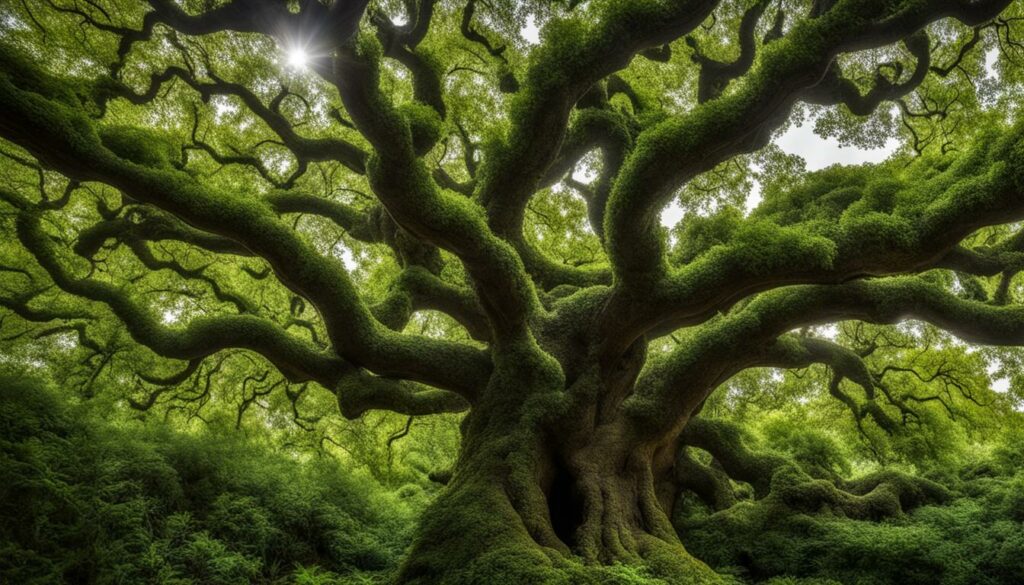If you are looking for a distinctive and elegant bonsai tree species, the oak bonsai is an excellent choice. With its impressive deciduous foliage and stately silhouette, the oak bonsai can add a touch of grace and sophistication to any indoor or outdoor environment. In this article, we will take you through a journey of exploring the majestic oak species and provide you with expert care tips to ensure the health and longevity of your miniature Quercus bonsai.
Key Takeaways:
- The oak bonsai is a distinctive and elegant species with impressive deciduous foliage and a stately silhouette.
- The oak bonsai requires proper care techniques such as watering, fertilizing, pruning, and repotting to ensure its health.
- Choosing the right oak species for your bonsai project is key for its survival and growth.
- Seasonal care is crucial for the health of oak bonsai, and exhibiting your miniature masterpiece can showcase your talent as a bonsai enthusiast.
- Avoid common mistakes, such as incorrect pruning techniques, overwatering, or insufficient lighting.
Understanding Oak Bonsai
Before delving into the care and cultivation of oak bonsai, it’s crucial to understand the characteristics and significance of this tree species. Oak is a species from the Quercus genus, which comprises over 600 different species of trees native to the Northern hemisphere.
Some of the most commonly used oak species for bonsai cultivation include the Pin Oak, Water Oak, and Shumard Oak. These species are known for their unique foliage, bark texture, and pronounced branching patterns, making them highly sought-after among bonsai enthusiasts.
In many cultures, the oak tree is revered as a symbol of strength, power, and longevity. In ancient Greek mythology, the oak was associated with the god Zeus, while the ancient Celts regarded the oak as the king of the forest, representing courage and protection. Due to this cultural significance, cultivating an oak bonsai can be seen as a way to honor this majestic and historic tree.
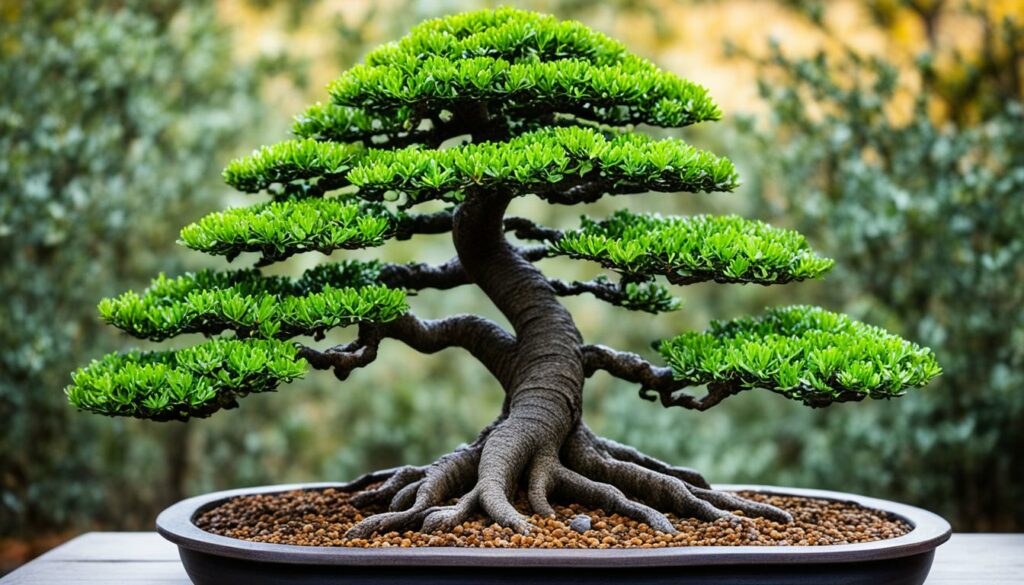
“Oak bonsai is a miniature representation of the might and grandeur of the oak tree, and with proper care and attention, it can thrive and become a true masterpiece.”
Choosing the Right Oak Species
Not all oak species are suitable for bonsai cultivation. While oak bonsai is a popular choice for its unique beauty, it is important to select the appropriate species to ensure the success of your project. Consider factors such as leaf size, growth pattern, and hardiness when choosing the right oak species for your bonsai.
Popular Oak Bonsai Species
| Species Name | Leaf Size | Growth Pattern | Hardiness |
|---|---|---|---|
| Pin Oak (Quercus palustris) | Medium | Upright | Zone 4-8 |
| White Oak (Quercus alba) | Large | Upright | Zone 3-9 |
| Red Oak (Quercus rubra) | Large | Upright/Spreading | Zone 3-8 |
| Japanese White Oak (Quercus myrsinifolia) | Small | Upright | Zone 6-9 |
Note:
Deciduous bonsai, such as oak bonsai, typically require a dormant phase during the winter months, making it crucial to select a species that can tolerate your local climate.
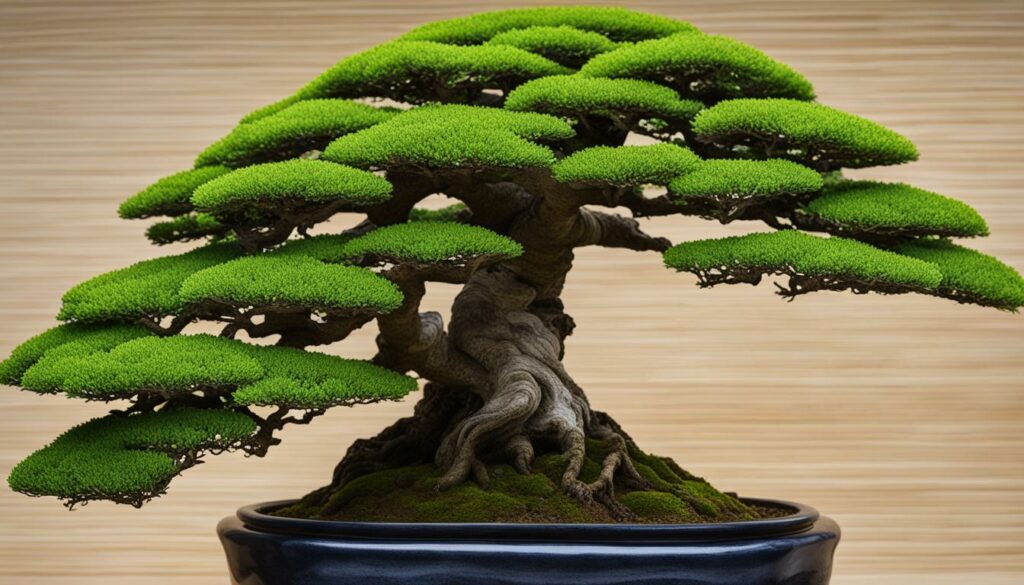
TIP: Consider your personal taste and the overall aesthetic you wish to achieve with your oak bonsai when selecting an oak species. Each tree species has its own unique characteristics that can influence the final look of your bonsai project.
Oak Bonsai Care Essentials
Proper care is essential to the health and success of your oak bonsai. Here are some specific guidelines to follow:
- Watering: Oak bonsai prefers moderate moisture. It’s important not to overwater or underwater your bonsai. Check the soil moisture level regularly, and water accordingly.
- Fertilizing: Use a balanced fertilizer during the growing season to encourage healthy foliage growth. Avoid fertilizing during the dormant season.
- Pruning: Regular pruning helps to maintain the tree’s shape and overall health. Use sterilized tools to remove dead, diseased, or unwanted branches.
- Repotting: Oak bonsai should be repotted every 2-3 years, or when the roots have outgrown the current container. Repot during the dormant season, using well-draining soil.
Remember to keep an eye on your oak bonsai’s overall health, and address any issues promptly. With proper care, your oak bonsai will thrive for many years to come.
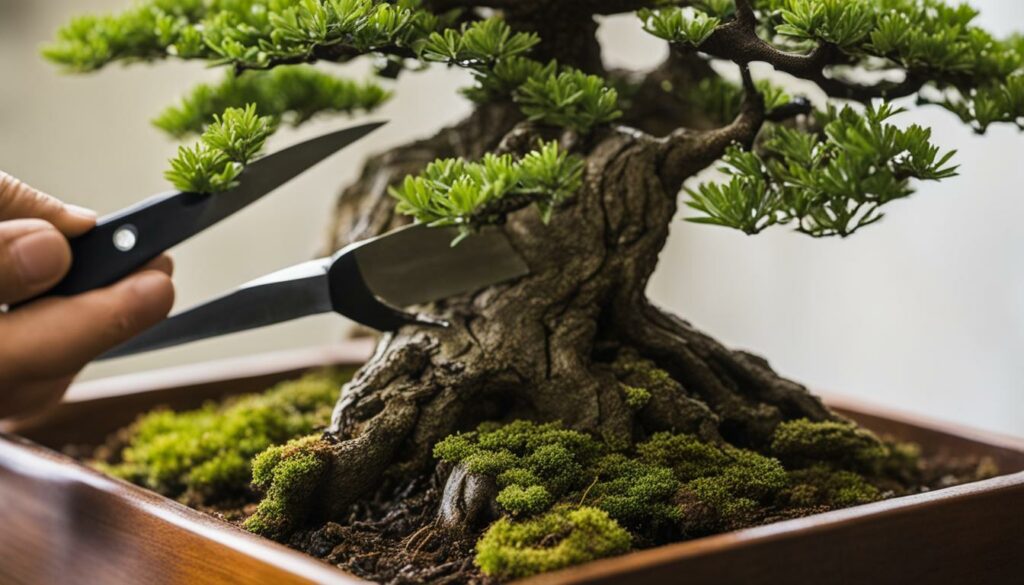
Shaping and Styling Oak Bonsai
As with any bonsai tree, shaping and styling your oak bonsai is an art form that requires precision and patience. By controlling the growth and form of your tree, you can create a unique aesthetic that represents your personal style and taste.
One of the key techniques for shaping oak bonsai is pruning. Regular pruning of the branches and foliage will help to maintain the desired size and shape of the tree, while also promoting healthy growth. When pruning, be sure to use sharp, clean tools and make precise cuts to avoid damaging the tree.
Wiring is another technique that can be used to control the shape and direction of your oak bonsai. By wrapping a wire around a branch and gently bending it into the desired position, you can encourage the branch to grow in a specific direction. Be sure to check the wire regularly to avoid causing damage to the branch.
Branch placement is also an important factor in shaping oak bonsai. By carefully selecting which branches to keep and which to remove, you can create an aesthetically pleasing design that showcases the unique features of the tree.
Remember that shaping and styling oak bonsai is a continuous process that requires ongoing care and attention. By experimenting with different techniques and styles, you can create a truly exceptional oak bonsai that reflects your passion and dedication.
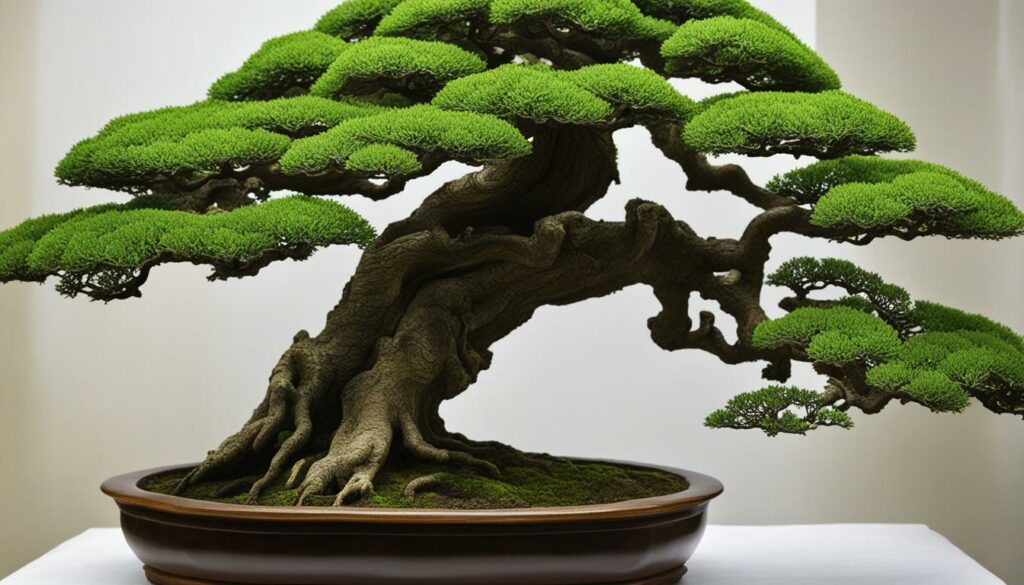
The Importance of Light and Temperature
Proper lighting and temperature are crucial factors in ensuring the health and growth of your oak bonsai. The amount and quality of light your bonsai receives will affect its photosynthesis, which is essential for healthy foliage and overall tree health. When it comes to temperature, oak bonsai are deciduous and require different care throughout the year.
The ideal lighting conditions for oak bonsai vary depending on the species and the time of year. For example, during the growing season, oak bonsai require full sun exposure to promote healthy growth, while in the winter, they prefer indirect sunlight to avoid drying out. Use a light meter to measure the amount of light your oak bonsai is receiving, and adjust its location accordingly.
The optimum temperature range for oak bonsai is between 60-75°F (15.5-24°C) during the growing season and 40-55°F (4.5-12.5°C) during the dormant period in the winter. Make sure your oak bonsai is not exposed to extreme temperatures, as this can damage its foliage and overall health.
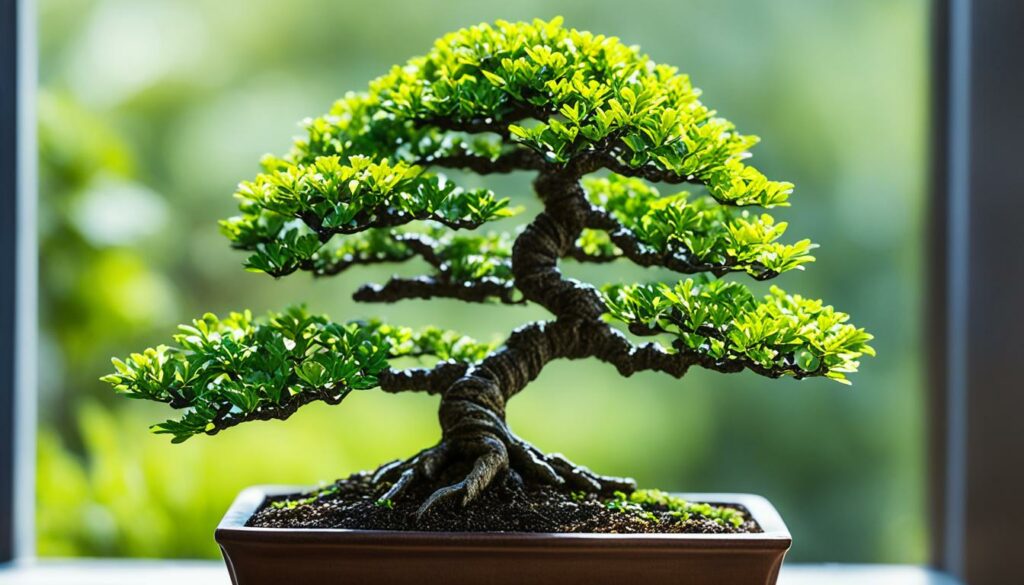
Light and Temperature Summary
| Bonsai Tree | Ideal Light Conditions | Ideal Temperature Range |
|---|---|---|
| Oak Bonsai | Full sun exposure during the growing season, indirect sunlight in winter | 60-75°F (15.5-24°C) during the growing season, 40-55°F (4.5-12.5°C) in the dormant period of winter |
| Deciduous Bonsai | Full sun exposure during the growing season, reduced light in winter | 40-60°F (4.5-15.5°C) during the dormant period |
| Quercus Bonsai | Full sun exposure during the growing season, indirect sunlight in winter | 60-75°F (15.5-24°C) during the growing season, 40-55°F (4.5-12.5°C) in the dormant period of winter |
Remember to regularly check the lighting and temperature conditions of your oak bonsai to ensure it is receiving the proper care. Proper lighting and temperature combined with other essential bonsai care practices will help your oak bonsai thrive and become a beautiful addition to your collection.
Oak Bonsai Pest and Disease Management
As with any plant, oak bonsai are susceptible to a variety of pests and diseases that can affect their growth and overall health. Identifying the problem early is critical to ensuring swift and effective treatment. Here are some common pests and diseases that may affect your oak bonsai:
Pests
| Pest | Description | Treatment |
|---|---|---|
| Spider Mites | Small insects that infest the leaves and cause yellowing and webbing. | Use insecticidal soap or neem oil to eliminate the mites. |
| Scale Insects | Small, oval-shaped insects that attach themselves to the trunk or branches and suck sap from the tree. | Use rubbing alcohol or horticultural oil to remove the scales. |
| Mealybugs | Soft-bodied, white insects that appear as fluffy patches on leaves and stems. | Use insecticidal soap or neem oil to eliminate the bugs. |
Diseases
Some common diseases that affect oak bonsai include:
- Leaf Spot
- Powdery Mildew
- Anthracnose
To prevent the spread of disease, remove and dispose of any infected leaves or branches immediately. Use a fungicide spray to treat the bonsai, following the product instructions carefully.
Regularly inspecting your oak bonsai for signs of pests and disease is crucial to maintaining its overall health. Keeping your bonsai in optimal growing conditions, such as providing adequate sunlight and proper watering and fertilization, can also help prevent pest and disease problems from arising.
Seasonal Care for Oak Bonsai
Proper care for oak bonsai is essential throughout the year, especially during different seasons. Being deciduous, oak bonsai require different care during winter, spring, summer, and fall. Here are some seasonal care guidelines to keep your Quercus bonsai healthy and thriving:
Winter Care
During winter, oak bonsai should be protected from freezing temperatures and frost. You can wrap your oak bonsai in a protective cover, such as burlap, to provide insulation. Place your oak bonsai in a sheltered location, away from harsh winds and winter storms. Water your oak bonsai sparingly during winter, as dormant trees require less water. Make sure the soil is moist, but not waterlogged.
Spring Care
Spring is the time for repotting your oak bonsai. It’s essential to repot your oak bonsai every two to three years, to ensure healthy root growth and development. Repot your oak bonsai in a well-draining soil mix, and prune any damaged or overgrown roots. Spring is also the time for fertilizing oak bonsai, to promote growth and health. Use a balanced, slow-release fertilizer to nourish your oak bonsai.
Summer Care
During summer, oak bonsai require frequent watering, as they tend to dry out quickly in hot weather. Water your oak bonsai regularly, making sure the soil is moist, but not waterlogged. Provide shade for your oak bonsai during the hottest part of the day, to prevent sunburn. This is also the time for pruning and shaping your oak bonsai, to maintain its desired shape and form.
Fall Care
During fall, oak bonsai prepare for dormancy. Reduce watering, as the tree’s need for water decreases. You can also fertilize your oak bonsai with a high phosphorus fertilizer, to encourage strong root growth before dormancy. This is also the time for leaf pruning, to reduce the size of leaves and promote new growth in spring.
“Seasonal care is essential for the health and success of your oak bonsai. By following these guidelines, you can ensure that your Quercus bonsai thrive throughout the year.”
Showcasing Your Oak Bonsai
After all the hard work and dedication you put into cultivating your oak bonsai, you may want to showcase it in bonsai exhibitions or competitions. When presenting your oak bonsai, there are a few things to keep in mind to ensure a successful display.
Presentation Techniques
When presenting your oak bonsai, consider using a stand to elevate it and create an eye-catching display. You can also use accent plants, rocks, or figurines to complement the overall aesthetic of your presentation.
Tip: Keep your presentation simple and allow the beauty of your oak bonsai to speak for itself. Avoid overcrowding the display with too many distractions.
Display Options
There are several display options to choose from when showcasing your oak bonsai. Consider participating in local bonsai exhibitions or competitions to gain exposure and connect with other bonsai enthusiasts. You can also display your oak bonsai in your home or office, or even gift it to a friend or family member who shares your love for bonsai.
Aesthetic Considerations
When presenting your oak bonsai, consider the overall aesthetic and ensure that it aligns with the principles of bonsai. The presentation should be simple, elegant, and highlight the unique features of your oak bonsai. Think of it as a work of art and showcase it accordingly.
Remember, presenting your oak bonsai is an opportunity to share your passion and hard work with others. Take pride in your presentation and enjoy the process of showcasing your masterpiece!
Common Oak Bonsai Mistakes to Avoid
Even experienced gardeners make mistakes when it comes to cultivating oak bonsai. However, as a beginner, it’s essential to avoid common pitfalls to ensure the success of your flourishing Quercus bonsai. In this section, we will discuss the most prevalent oak bonsai mistakes you should avoid.
Overwatering Oak Bonsai
One of the most common mistakes that bonsai beginners make is overwatering their oak bonsai. Remember, the roots of oak bonsai need oxygen to grow correctly. Too much water can lead to root rot or other diseases, which ultimately affect the tree’s health. Make sure to water your oak bonsai in moderation. Check the soil regularly and water it only when it appears dry.
Insufficient Lighting
Proper lighting plays a vital role in the growth and health of oak bonsai. Insufficient light can slow down or even stop the growth of oak bonsai, leading to poor development of new foliage. Place your oak bonsai in a bright, sunny location but avoid direct sunlight during peak hours, which can scorch the leaves.
Incorrect Pruning Techniques
Pruning is an essential skill that every oak bonsai cultivator must master. However, using the wrong pruning techniques can harm your oak bonsai. Avoid pruning oak bonsai during the winter season as this can damage the tree. Understand the different types of pruning, including maintenance pruning, structural pruning, and pinching, and apply them accordingly.
Low Humidity
The most common mistake is keeping your oak bonsai in a low humidity environment. Oak trees naturally require a humid environment. Low humidity can lead to browning of leaves. You can, however, increase the humidity level by placing a tray of water near the tree or misting the leaves often.
Avoiding these common oak bonsai mistakes will ensure the success and health of your oak bonsai.
Advancing Your Oak Bonsai Journey
Now that you have mastered the basics of oak bonsai cultivation, you may want to explore more advanced techniques to take your skills to the next level. One such technique is air layering, which involves making a cut in a branch and wrapping it with a moist material to encourage root growth. This creates a new tree that is genetically identical to the original, which you can separate and cultivate as a separate bonsai.
Grafting is another advanced technique that involves joining a scion (a small branch of one tree) with a rootstock (the main trunk of another tree) to create a new plant with desirable characteristics. This allows you to create unique oak bonsai varieties that may not exist in nature.
If you are feeling particularly adventurous, you may want to try creating more intricate designs, such as cascade or semi-cascade styles, which involve training the trunk and branches to grow at an angle or in a curved shape. These styles require patience and precision, but can result in stunning oak bonsai creations.
Remember, advancing your oak bonsai journey requires dedication, patience, and a willingness to learn. Keep practicing your skills and experimenting with new techniques to create the perfect oak bonsai masterpiece.
FAQ
What are some common oak species used for bonsai?
Some common oak species used for bonsai include Quercus robur (English oak), Quercus serrata (sawtooth oak), and Quercus palustris (pin oak).
How often should I water my oak bonsai?
Oak bonsai should be watered thoroughly when the top inch of soil feels dry. However, it’s important to avoid overwatering as it can cause root rot. Monitor the moisture level and adjust the watering frequency accordingly.
When should I prune my oak bonsai?
Pruning should be done during the dormant season, typically in late winter or early spring before new growth appears. Avoid pruning during the active growing season as it may stress the tree.
Can I keep my oak bonsai indoors?
While oak bonsai can tolerate occasional indoor conditions, they are best suited for outdoor cultivation. They require a period of dormancy during winter, exposure to natural sunlight, and adequate airflow.
How can I protect my oak bonsai during winter?
Oak bonsai are hardy trees, but they still need protection during harsh winter conditions. Insulate the roots by using a layer of mulch or placing the pot in a sheltered location. You can also wrap the branches with burlap to protect them from freezing winds.
What should I do if my oak bonsai is infested with pests?
If you notice pests on your oak bonsai, such as aphids or scale insects, remove them manually or use an appropriate insecticidal soap. Regularly inspect your tree and take action at the first sign of infestation to prevent the spread of pests.
How do I create a desired shape for my oak bonsai?
Shaping oak bonsai requires careful pruning and wiring. Prune unwanted branches and wire the remaining branches into the desired position, taking care not to damage the delicate bark. Regularly maintain and adjust the wiring as the tree grows.
Should I repot my oak bonsai every year?
Oak bonsai generally need to be repotted every two to three years in early spring, just before the growing season begins. However, it’s important to assess the root health and growth rate of your specific oak bonsai to determine the ideal repotting frequency.
How can I display my oak bonsai in an exhibition?
When displaying your oak bonsai in an exhibition, consider the overall aesthetic presentation. Choose an appropriate display stand and accentuate the tree with complementary moss, rocks, and other decorative elements. Ensure that the tree is well-maintained and presented in its best form.
Are there any beginner mistakes to avoid when growing oak bonsai?
Some common beginner mistakes to avoid when growing oak bonsai include overwatering, improper pruning techniques, using incorrect soil mixtures, and exposing the tree to extreme temperature fluctuations. Research and understand the specific care requirements of oak bonsai to prevent these mistakes.
What advanced techniques can I explore with my oak bonsai?
As you gain experience, you can explore advanced techniques such as air layering, grafting, and creating intricate designs. These techniques allow you to refine the structure and aesthetics of your oak bonsai and take your skills to the next level.
